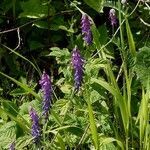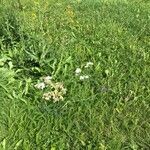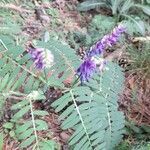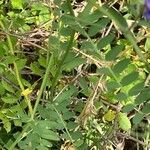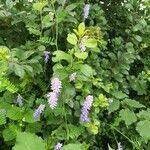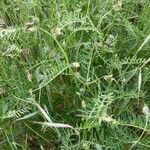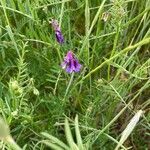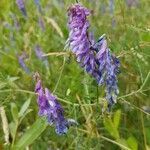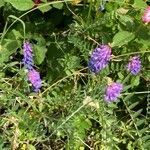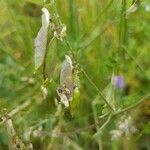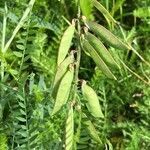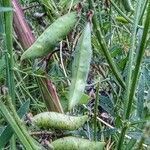Scrambling perennial; stem moderately to densely clothed in mostly appressed hairs. Lvs densely clothed in appressed hairs above and below; tendrils branched at least in upper lvs; leaflets in c. 8-10 pairs, sometimes alternate, linear to ovate-oblong, 5-25 mm long; stipules entire or with 1, narrow, adaxial, basal lobe. Infl. > lvs, 10-45-flowered. Peduncle much > fls. Pedicel 1-2 mm long. Calyx slightly gibbous at base, moderately to densely hairy; calyx teeth very unequal; lower teeth ± = tube; upper teeth much < tube. Corolla blue to bluish purple, c. 8-12 mm long; limb of standard ± = claw. Pod glabrous, brown, 2-6-seeded, 16-26 mm long; seeds dark brown or mottled, 2-3 mm diam.; hilum 1/4-⅓ of circumference.
Trailing or climbing perennial to 1 m; lfls usually 5–11 pairs, linear to narrowly oblong, 1–3 cm, with few lateral veins leaving the midrib at a very narrow angle; stipules entire; racemes long-peduncled, dense, secund, equaling or exceeding the subtending lf, with 20–50 crowded blue (white) fls 8–13 mm; cal-tube oblique, gibbous at base, 2–3 mm, the upper lobes broadly triangular, 0.3–0.7 mm, the lowest linear-triangular, 1.3–2.5 mm; blade of the standard about as long as the claw; 2n=14, 28. Fields, roadsides, and meadows; native of Eurasia and possibly ne. N. Amer., widely naturalized in n. U.S. and s. Can., especially eastward, and found essentially throughout our range. June–Aug.
Annual, scrambling or climbing herb, 0.6-2.0 m high; stems numerously branched, climbing by means of tendrils, fairly hairy. Leaves with rachis terminating in slender, ramified filiform, tendrils. Leaflets 5-15 mm long. Inflorescences of long, slender racemes; flowers drooping, second; peduncles 30 mm long. Flowers white, ± 5 mm long. Pod 10-15 mm long with nail or claw-like tip. Seeds ± 4-8.
An annual climbing herb. It is hairy. The leaves have leaflets along the stalk. There are 8-24 leaflets and a tendril at the end. The leaflets are 7-15 cm long by 2-8 mm wide. The flowers are pinkish-blue. The pods are flat and oblong. They are 2-4 cm long and with an oblique point at the end. There are 2-5 seeds. They are black.
